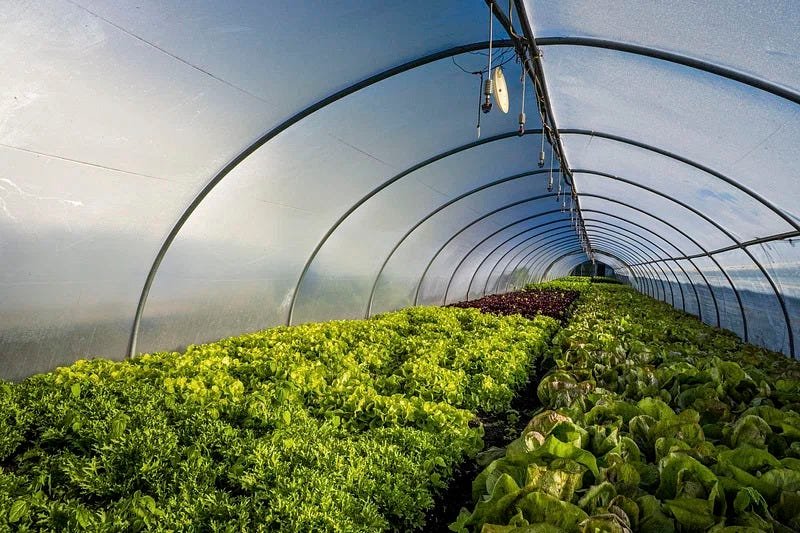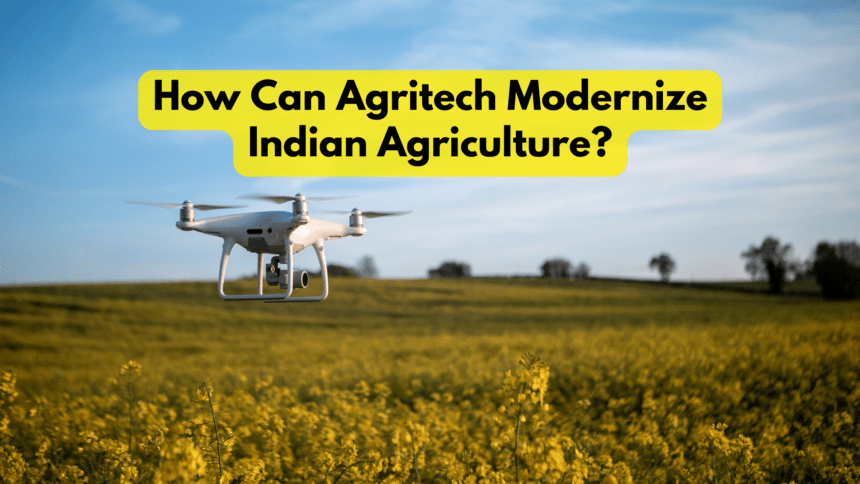Introduction
The Historical Landscape of Indian Agriculture
Indian agriculture has a rich history, deeply intertwined with the country’s cultural and economic fabric. Traditionally, agriculture in India has been practiced using age-old methods handed down over generations, with a strong reliance on manual labor and natural farming techniques.
The Imperative for Technological Modernization
As India marches towards a future of exponential population growth and increasing demands for food security, there is an urgent need to modernize its agricultural practices. Technological advancements offer the promise of increased productivity, sustainability, and efficiency, ensuring a better tomorrow for Indian agriculture.
Precision Agriculture

Fundamentals of Precision Farming
Precision agriculture, also known as precision farming, is a farming management concept that utilizes advanced technologies to optimize field-level management with regard to crop farming. It involves the use of GPS technology, drones, and other tools to precisely manage inputs like water, fertilizers, and pesticides.
Technological Tools and Techniques
Precision farming employs various tools and techniques such as GPS-guided tractors, drones, sensors, and data analytics. These technologies enable farmers to monitor and control every aspect of crop production, leading to higher yields, reduced waste, and improved sustainability.
Internet of Things (IoT) in Agriculture
IoT Devices Revolutionizing Farming
The Internet of Things (IoT) has brought about a revolution in agriculture by connecting various devices and sensors on the farm to the internet. This connectivity allows farmers to collect real-time data on weather conditions, soil moisture levels, and crop health.
Benefits of Real-Time Monitoring
Real-time monitoring enables farmers to make informed decisions promptly. They can adjust irrigation schedules, apply fertilizers, and take pest control measures based on actual data, leading to optimized resource utilization and improved crop yields.
Drones in Modern Agriculture
Various Applications of Agricultural Drones
Agricultural drones are being used for a wide range of applications in modern agriculture. They can be used for aerial surveillance, mapping, crop monitoring, and even crop dusting. Drones provide farmers with a bird’s-eye view of their fields, enabling them to detect problems early and take timely action.
Enhanced Crop Management through Aerial Surveillance
With drones, farmers can monitor their crops more efficiently and effectively. They can identify areas of stress, such as water or nutrient deficiencies, and take corrective actions. Drones also help in pest detection and management, reducing the need for chemical inputs.
Genetic Engineering and Biotechnology
Introduction to Genetically Modified Crops
Genetic engineering and biotechnology have led to the development of genetically modified (GM) crops. These crops are engineered to possess specific traits such as pest resistance, drought tolerance, and increased nutritional content.
Pros and Cons of GMOs in Indian Agriculture
While GM crops offer several benefits, including increased yields and reduced use of chemical pesticides, they also raise concerns about environmental impact and food safety. The debate over the use of GMOs in Indian agriculture continues to be a contentious issue.
Artificial Intelligence and Machine Learning
AI-Driven Predictive Analytics
Artificial Intelligence (AI) and machine learning are revolutionizing agriculture by providing farmers with predictive analytics. These technologies can analyze data from various sources, such as weather patterns and soil conditions, to predict crop yields and optimize farming practices.
Machine Learning for Pest and Disease Control
Machine learning algorithms can also be used for pest and disease control. By analyzing data on pest behavior and crop susceptibility, these algorithms can help farmers make informed decisions about pest management strategies.
Blockchain Technology in Agriculture
Ensuring Transparency in the Supply Chain
Blockchain technology is being used in agriculture to ensure transparency in the supply chain. Every transaction, from seed to sale, is recorded on a secure, tamper-proof ledger, providing consumers with traceability and authenticity.
The Role of Blockchain in Food Safety
Blockchain technology can also improve food safety by enabling faster and more accurate tracking of food products. In the event of a foodborne illness outbreak, blockchain can help trace the source of contamination quickly, reducing the impact on public health.
Sustainable Agricultural Practices
Organic Farming Methods
Sustainable agriculture focuses on organic farming methods that minimize the use of synthetic inputs. These methods promote soil health, biodiversity, and environmental sustainability.
Techniques for Water Conservation
Water conservation is a key aspect of sustainable agriculture. Techniques such as drip irrigation, rainwater harvesting, and precision watering help farmers optimize water use and reduce water wastage.
Vertical Farming Innovations
Understanding Vertical Farming
Vertical farming is a method of growing crops in vertically stacked layers, often in controlled indoor environments. This method maximizes the use of space and resources, making it ideal for urban areas.
Benefits of Urban Agriculture
Urban agriculture through vertical farming has several benefits, including increased food production, reduced transportation costs, and improved food security for urban populations.
Renewable Energy in Agriculture
Adoption of Solar-Powered Systems
Renewable energy sources such as solar power are being increasingly adopted in agriculture. Solar-powered irrigation systems and other renewable energy solutions help farmers reduce their reliance on fossil fuels and lower their carbon footprint.
Other Renewable Energy Solutions
In addition to solar power, wind and biomass energy are also being harnessed in agriculture. These renewable energy sources provide farmers with reliable and sustainable power options.
Agri-Fintech Solutions
Digital Financial Services for Farmers
Agri-fintech solutions offer digital financial services tailored to the needs of farmers. These services include mobile payment platforms, digital lending, and insurance services, providing farmers with greater financial inclusion and security.
Enhancing Access to Credit and Insurance
Access to credit and insurance is crucial for farmers, especially in times of crop failure or natural disasters. Agri-fintech solutions help farmers access these services more easily, enabling them to manage risks and invest in their farms.
Government Initiatives and Policies
Key Schemes Supporting Agritech
The Indian government has launched several schemes to support the adoption of agritech. These schemes provide financial incentives, training, and infrastructure support to farmers and agritech companies.
Policy Measures to Encourage Technology Adoption
Policy measures such as subsidies, tax incentives, and regulatory reforms are essential to encourage the adoption of agritech. Government support is crucial in driving the technological transformation of Indian agriculture.
Challenges in Agritech Implementation
Identifying Major Obstacles
The implementation of agritech faces several challenges, including high costs, lack of awareness, and resistance to change. Small-scale farmers, in particular, may find it difficult to adopt new technologies due to these barriers.
Strategies to Overcome Implementation Challenges
To overcome these challenges, education, training, and financial support are essential. Government and non-governmental organizations can play a key role in providing the necessary resources and support to farmers.
Success Stories and Case Studies
Inspiring Examples of Agritech Success
In states like Karnataka and Andhra Pradesh, farmers have successfully implemented precision agriculture techniques, resulting in significant increases in crop yields and incomes. Similarly, the use of drones for crop monitoring and management has shown positive results in states like Gujarat and Maharashtra.
Positive Impacts on Farmer Livelihoods
The adoption of agritech has had a profound impact on farmer livelihoods. By increasing productivity and reducing input costs, agritech has helped farmers improve their economic status and provide better for their families. Additionally, the use of sustainable agricultural practices has enhanced soil fertility and reduced environmental degradation, ensuring a more sustainable future for farming communities.
Emerging Technologies
Future Technological Innovations
Looking ahead, the future of Indian agriculture is bright with innovations such as robotics, gene editing, and advanced AI expected to further revolutionize the sector. These technologies have the potential to address key challenges such as labor shortages, pest outbreaks, and climate change, making farming more efficient and sustainable.
Potential Impact on Indian Agriculture
The potential impact of these emerging technologies on Indian agriculture is immense. By improving efficiency, productivity, and sustainability, these technologies can help ensure food security for India’s growing population while also reducing the environmental footprint of agriculture.
Educational Programs and Training
Importance of Farmer Education
Education is crucial for the successful adoption of agritech. Farmers need to understand the benefits and applications of new technologies to integrate them into their farming practices effectively.
Training Programs to Facilitate Agritech Adoption
To facilitate the adoption of agritech, training programs are essential. These programs should be designed to provide farmers with hands-on experience and practical knowledge of new technologies, helping them make informed decisions about their implementation on the farm.
Collaboration and Partnerships
Role of Public-Private Partnerships
Public-private partnerships play a vital role in promoting agritech. By bringing together the resources and expertise of both sectors, these partnerships can drive innovation and ensure the successful implementation of new technologies in agriculture.
Collaborations with Research Institutions
Research institutions play a key role in developing and testing new agritech solutions. Collaborations between research institutions and farmers can help ensure that these technologies meet the needs of the agricultural community and are effectively adopted on the ground.
Market Access and Export Potential
Enhancing Market Access through Technology
Technological advancements can help farmers access markets more easily, allowing them to sell their produce directly to consumers. Online platforms and digital marketplaces can help farmers reach a wider audience and improve their income potential.
Boosting Agricultural Exports
By improving the quality and quantity of agricultural produce, agritech can help boost agricultural exports. This can have a significant impact on the Indian economy, providing farmers with new opportunities for growth and development.
Climate Resilience and Agritech
Technologies for Climate-Resilient Farming
Climate change is a significant challenge for agriculture, but agritech can help farmers adapt to changing conditions. Technologies such as drought-resistant crops, precision irrigation, and weather forecasting can help farmers mitigate the impacts of climate change on their farms.
Mitigating Climate Change Impacts
Agritech can also play a role in mitigating the effects of climate change on agriculture. By promoting sustainable practices and reducing greenhouse gas emissions, agritech can help ensure a more sustainable future for farming communities in India.
Vision for the Future
Imagining Indian Agriculture in 2050
In the future, Indian agriculture is likely to be characterized by highly efficient and sustainable practices. Technologies such as AI, robotics, and biotechnology will play a central role in increasing productivity and ensuring food security for a growing population.
Roadmap to Achieve Technological Integration
To achieve this vision, it is essential to focus on education, infrastructure development, and policy support. Farmers need to be educated about new technologies, and infrastructure must be developed to support their implementation. Additionally, supportive policies and incentives can encourage farmers to adopt sustainable and technologically advanced practices.
Conclusion
In conclusion, agritech advancements hold tremendous promise for modernizing Indian agriculture and ensuring a better future for generations to come. By harnessing the power of technology, sustainable practices, and collaborative partnerships, Indian farmers can overcome challenges, increase productivity, and create a resilient agricultural sector that can meet the demands of a growing population while preserving the environment. With the right vision, strategies, and collective efforts, Indian agriculture can thrive in the 21st century and beyond.













